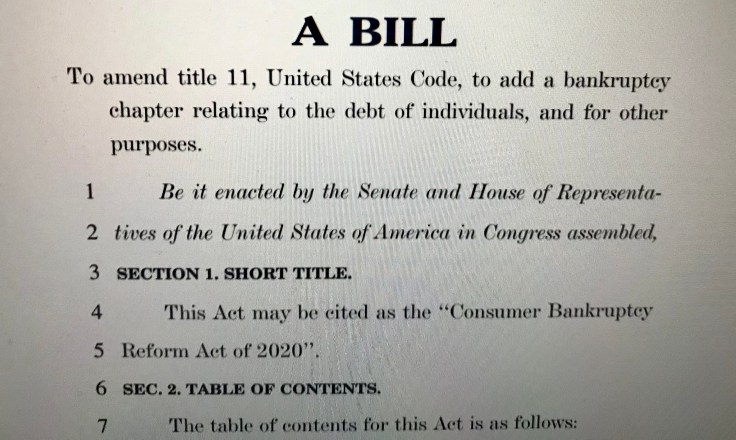
By: Donald L Swanson
A new bankruptcy Bill in Congress is titled, “Consumer Bankruptcy Reform Act of 2020.” It would replace the existing Chapter 7 and Chapter 13 of the Bankruptcy Code with a new Chapter 10. It is 188 pages long and includes an Ombuds position in a mediator-type role.
What follows is taken from the official “Consumer Bankruptcy Reform Act Summary.”
Purpose
The declared purpose of the Bill is to “modernize the consumer bankruptcy system to make it easier for individuals and families forced into bankruptcy to get back on their feet,” by making it “easier and less expensive” for consumers “to get financial relief.”
Specific provisions
The Bill provides a new Chapter 10, with two plan routes for individuals to file bankruptcy:
- Plans for, (i) a no-payment discharge of all debts for low-income/low-asset debtors, except for child support or debts incurred by fraud, or (ii) a minimum payment discharge for debtors with valuable assets or annual income over 135% of certain standards; or
- Debt-specific repayment plans for, (i) unsecured debt, like medical, credit card, and student loan debt, with payments over 3 years secured by a lien on the debtor’s nonexempt property, and a discharge at plan’s end, (ii) secured debts like home mortgage and car loans being repaid directly by debtor, in which debtor’s income is a factor, and (iii) payment of attorney fees through the plan.
The new Chapter 10 would also:
- Allow home renters to continue in the premises without curing certain payment defaults.
- Eliminate exemptions under state law and create, (i) a new homestead exemption based on a “federal floor keyed to FHFA conforming loan limit for the debtor’s county of residence,” and (ii) an additional set of federal exemptions, including a $35,000 wildcard exemption;
- Allow debtors with mortgages to, (i) sell encumbered property free and clear of liens, and (ii) modify their mortgage, based on market value of the property, with reduced interest rates;
- Allow car owners to pay liquidation value to keep the car (excluding cars purchased 90 days before bankruptcy);
- Allow private and federal student loans to be discharge like other unsecured debt;
- On race-related issues, (i) certain criminal justice fines and fees are dischargeable, (ii) prevents discharge of debts for civil rights violations, and (iii) requires collection of data on race, gender, and age;
- On gender-related issues, (i) moves to an income- and asset-only based calculation of repayment ability, (ii) creates a lump-sum personal property exemption adjusted by the number of dependents, rather than number of bankruptcy filers, and (iii) protects rights to alimony, child support, child tax credit, and Earned Income Tax Credit.
The proposed Chapter 10 also addresses loopholes for the wealthy and for corporate misconduct:
- Eliminates the intent requirement for fraudulent transfer of a self-settled trust;
- Eliminates spendthrift trusts rights, with carve outs for bona fide disability trusts;
- Disallows claims when a federal consumer financial law is violated;
- Expands Fair Debt Collection Practices Act to cover bankruptcy claims filed without a reasonable and good faith belief of viability under the statute of limitations;
- Makes a knowing collection effort on a discharged debt an unfair practice, unless debtor voluntarily chooses to repay the debt;
- Allows lawsuits against creditors and collectors who try to collect debts discharged in bankruptcy, including class action lawsuits, and eliminates mandatory arbitration in such matters;
- Establishes a Consumer Bankruptcy Ombuds to handle consumer bankruptcy complaints;
- Expands the CFPB’s supervisory authority to all lenders that make loans at over a 36% military APR rate, and makes the Bankruptcy Code an “enumerated consumer law.”
Conclusion
It will be interesting to see how this new Bill plays out in the political realm, as we move into the 2021 calendar year.
** If you find this article of value, please feel free to share. If you’d like to discuss, let me know.
Leave a comment